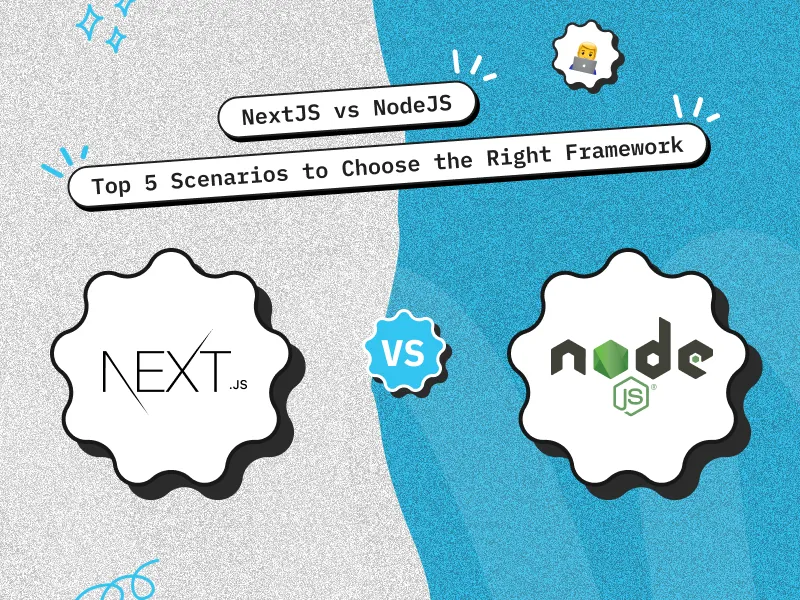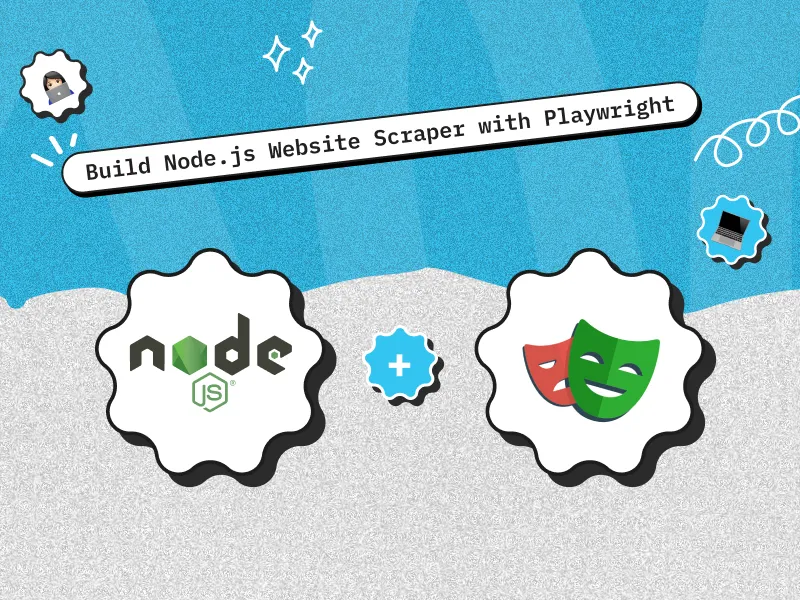Quick Summary
Choosing between NextJS and NodeJS depends on your project requirements. NextJS is ideal for front-end-focused, SEO-friendly applications, while NodeJS is perfect for backend development and scalable APIs. This article explores the differences, scenarios, and key decision-making factors to help you make the best choice.
Introduction
When building a web application, selecting the right framework or runtime environment is crucial. Both NextJS and NodeJS serve distinct purposes, and understanding their strengths will help you make an informed decision. This article breaks down their differences, best-use scenarios, and factors to consider when choosing the best fit for your project.
What is NextJS?
NextJS is a powerful React-based framework designed for building server-rendered and static websites. Known for its simplicity and performance, NextJS provides developers with features like:
- Server-Side Rendering (SSR): Enhancing performance and SEO.
- Static Site Generation (SSG): Creating fast and scalable websites.
- Built-in Routing: Simplifying navigation without additional libraries.
- API Routes: Enabling backend functionality within a single framework.
Quick Read: Node JS vs JavaScript
What is NodeJS?
Node.js is a JavaScript runtime environment built on Google Chrome’s V8 engine, enabling fast code execution outside the browser. It uses an event-driven, non-blocking I/O model, making it ideal for scalable, real-time applications like chat apps and online games.
For optimal performance and scalability, it’s essential to hire skilled NodeJS developers for your project, ensuring efficient backend development and leveraging Node.js’s vast ecosystem of tools and libraries.
- Event-Driven Architecture: Allowing efficient handling of multiple connections.
- Non-Blocking I/O: Ensuring high scalability and performance.
- Extensive Package Ecosystem: With npm, developers have access to thousands of modules.
Quick Read: React vs Node JS
NextJS vs NodeJS: Key Differences
Next.js and Node.js serve different purposes in the web development ecosystem. Here’s a breakdown of their key differences:
| Feature | NextJS | NodeJS |
| Type | Frontend framework (built on React) | Backend runtime environment |
| Usage | Web applications with SSR, SSG, and static sites | Server-side applications, APIs, and backend logic |
| Routing | File-based routing (automatic) | Requires manual routing (e.g., Express.js) |
| Rendering | Supports SSR, SSG, and client-side rendering | Doesn’t handle rendering directly |
| Performance | Optimized for frontend with automatic optimizations | Efficient backend processing for concurrent requests |
| Data Fetching | Supports getServerSideProps, getStaticProps, and API routes | Requires third-party frameworks for API handling |
Top 5 Scenarios to Choose the Right Framework
Choosing the right framework for your project can significantly impact performance, scalability, and maintainability. Here are the top five scenarios where NextJS and NodeJS shine, helping you make an informed decision.
Scenario 1: Building Dynamic Web Applications
Dynamic web applications require seamless user interactions, fast updates, and efficient state management.
- Why choose NextJS for dynamic frontends? NextJS provides server-side rendering (SSR) and static site generation (SSG), optimizing performance while delivering dynamic content efficiently.
- When to prefer NodeJS for backend-heavy projects? If your project involves heavy backend processing, NodeJS ensures high-speed asynchronous execution, handling multiple requests efficiently.
Scenario 2: Developing Static Websites or Blogs
For content-driven platforms, static websites improve loading speed and user experience.
- NextJS’s static site generation advantages: With SSG, NextJS pre-renders pages at build time, enhancing performance and SEO.
- NodeJS as an underlying backend for APIs: While NextJS handles static content, NodeJS can power backend APIs, serving dynamic data when needed.
Scenario 3: Real-time Applications
Applications like chat platforms, live notifications, and collaborative tools require real-time data exchange.
- NodeJS for handling WebSocket connections and real-time data: NodeJS, with its event-driven, non-blocking architecture, excels at real-time applications through WebSockets.
- Limited applicability of NextJS in such scenarios: NextJS focuses on rendering and routing, making it less suited for real-time interactions.
Scenario 4: SEO and Performance-Optimized Websites
For businesses prioritizing SEO, faster page loads and better indexing are critical.
- NextJS’s SSR benefits for SEO: Server-side rendering improves SEO rankings by ensuring content is available to search engine crawlers instantly.
- When NodeJS can complement as a backend for performance: NodeJS can be used to serve optimized data, reducing load times and improving responsiveness.
Scenario 5: Full-stack Development Needs
For end-to-end solutions, a full-stack approach ensures seamless integration between frontend and backend.
- Combining NextJS with NodeJS for seamless full-stack solutions: Using NextJS for frontend rendering and NodeJS for backend APIs creates a cohesive ecosystem.
- When to use one over the other depending on project scope: Choose NextJS when frontend rendering and SEO matter; opt for NodeJS when backend logic and real-time data processing are priorities.
NextJS vs NodeJS: Key Factors to Consider
When choosing between NextJS and NodeJS, it’s essential to understand their differences and how they align with your project requirements. Here are key factors to consider:
1. Purpose and Use Cases
- NextJS: A React-based framework used primarily for server-side rendering (SSR) and static site generation (SSG). Ideal for building SEO-friendly web applications and complex front-end solutions.
- NodeJS: A runtime environment for executing JavaScript on the server side. Used for building backend services, APIs, and full-stack applications.
2. Rendering Approach
- NextJS: Supports SSR, SSG, and Client-Side Rendering (CSR), making it versatile for dynamic and static content delivery.
- NodeJS: Focuses on server-side operations, enabling fast and lightweight handling of backend tasks but requires additional libraries or frameworks (like Express.js) for rendering.
3. Performance
- NextJS: Optimized for performance with built-in features like image optimization, automatic code splitting, and incremental static regeneration.
- NodeJS: Highly efficient for handling I/O-intensive tasks but requires custom implementation for caching and performance optimizations.
4. Learning Curve and Ecosystem
- NextJS: Easier to learn for developers familiar with React, with a rich ecosystem tailored for front-end development.
- NodeJS: A steeper learning curve for beginners, especially when setting up complex backend systems, but offers vast flexibility and control.
5. Community and Support
- NextJS: Backed by Vercel, with an active community and frequent updates tailored to front-end developers.
- NodeJS: A well-established and mature ecosystem with extensive community support and a wide range of libraries.
6. Scalability
- NextJS: Scales well for content-heavy front-end applications but relies on a robust backend (often built with Node.js) for handling large-scale systems.
- NodeJS: Highly scalable for backend operations, handling concurrent connections efficiently using its event-driven architecture.
Conclusion
Both NextJS and NodeJS are powerful tools in a developer’s toolkit, each excelling in different scenarios. By understanding the unique strengths of these frameworks and evaluating your project’s requirements, you can make an informed decision or hire NodeJS developers to ensure the best approach. Whether you’re building a static website, a dynamic application, or a full-stack solution, choosing the right framework can significantly impact your project’s success.
If you’re still unsure which option suits your needs, consulting with experienced professionals can help you navigate the decision-making process.
FAQs on NextJS vs NodeJS
1. Can I use NextJS and NodeJS together?
Ans: Yes, NextJS can run on a NodeJS server, allowing full-stack development with API routes.
2. Which is better for SEO, NextJS or NodeJS?
Ans: NextJS is better for SEO because it supports server-side rendering (SSR) and static site generation (SSG).
3. Is NextJS good for backend development?
Ans: NextJS supports backend development with API routes, but it is not as flexible as a dedicated NodeJS backend.
4. When should I use NodeJS over NextJS?
Ans: Use NodeJS for backend services, APIs, microservices, and real-time applications.
5. Is NextJS faster than NodeJS?
Ans: NextJS optimizes frontend performance, but NodeJS is essential for handling backend logic efficiently.
6. How to Build a Web Scraper with Node.js?
Ans: To build a Web Scraper with Node.js, use Cheerio with Axios to fetch and parse HTML in Node.js (npm install cheerio axios). For JavaScript-rendered sites, use Puppeteer. Always check robots.txt for compliance.











 30 mins free Consulting
30 mins free Consulting 
 5 min read
5 min read 







 Love we get from the world
Love we get from the world 